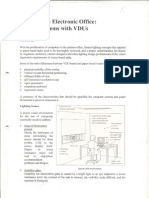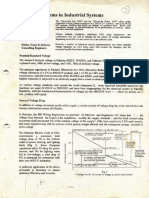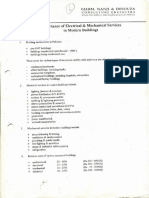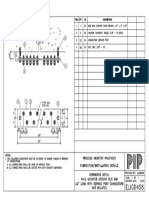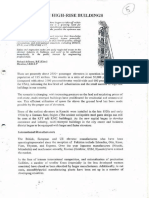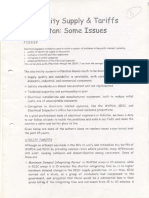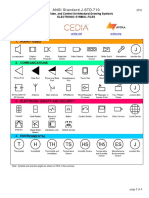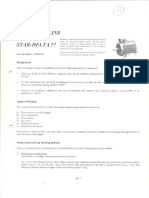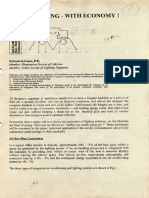0 ratings0% found this document useful (0 votes)
52 viewsDoes Your Earthing System Provide Safety
Does Your Earthing System Provide Safety
Uploaded by
naveedfndtechnical paper
Copyright:
© All Rights Reserved
Available Formats
Download as PDF or read online from Scribd
Does Your Earthing System Provide Safety
Does Your Earthing System Provide Safety
Uploaded by
naveedfnd0 ratings0% found this document useful (0 votes)
52 views8 pagestechnical paper
Original Title
Does your Earthing system provide safety
Copyright
© © All Rights Reserved
Available Formats
PDF or read online from Scribd
Share this document
Did you find this document useful?
Is this content inappropriate?
technical paper
Copyright:
© All Rights Reserved
Available Formats
Download as PDF or read online from Scribd
Download as pdf
0 ratings0% found this document useful (0 votes)
52 views8 pagesDoes Your Earthing System Provide Safety
Does Your Earthing System Provide Safety
Uploaded by
naveedfndtechnical paper
Copyright:
© All Rights Reserved
Available Formats
Download as PDF or read online from Scribd
Download as pdf
You are on page 1of 8
DOES YOUR EARTHING SYSTEM PROVIDE SAPETY?
There exists a popular notion in Pakistan, among technical and
non-technical circles, that the connection of one (or two!)
earth wires to various items of electrical equipment, the
burial of a copper plate at a reasonable depth (varying from
10 to 25 feet) in the ground, and attaining a small value of
earth electrode resistance (less than one ohm!), constitutes a
system of safety from electric shock
Not so! says the 15th Edition of the “Regulations for
Electrical Installations” formulated by the Institution of
Electrical Engineers, UK. Known as the Wiring Regulations, the
code is the one generally quoted in local specifications for
electrical installations.
Chapter 41 deals with “protection against electric shock’, and
section 413-2 to ‘section 413-17 covers “protection by earthed
equipotential bonding and automatic disconnection of supply
Sounds complicated? It is - and it is not!
System Earthing
Appendix 3 of the 15th Edition describes the various types of
system earthing: the two main types used in Pakistan today are
shown below:
The TN-S system (Fig 1) applies to all loads fed by cables
directly from a substation, with the protective conductor
running along with the cable in the form of armour/metal
sheath or separate circuit protective conductors: a metallic
return path for the fault current to the neutral of the
transformer is thus established (the neutral earth electrode
and the protective earth electrode are one, or, if separate,
are bonded together)
The TT system (Fig.2) applies to all loads fed by overhead
lines, with a separate consumer’s earth electrode distinct
from the transformer neutral earth electrode. As no reliable
metallic return path for the fault current to the transformer
neutral can be established, the fault current must flow
through an actual earth path between the two electrodes.
SOURCE oF ENERCY
PROTECTIVE
conouctoR.
consumers’
c
source |
earth |
INSTALLATION
ste |
SEPARATE NEUTRAL AND PROTECTIVE CONDUCTORS THROUGHOUT 8YSTEH.
THE PROTECTIVE CONOUCTOR (PED 18 THE METALLIC COVERING OF THE CABLE
SUPPLTING THE INSTALLATIONS OR A SEPARATE CONDUCTOR.
ALL EXPOSED CONDUCTIVE PARTS. OF AN INSTALLATION ARE CONNECTED TO THIS
PROTECTIVE CONDUCTOR VIA THE MAIN EARTHING TERMINAL OF THE INSTALLATION.
er a =
Electric Shocks
It must be clearly understood that when a person receives an
electric shock, current travels through his body into the
ground, and then returns to the earthed neutral of the
transformer a
There are two types (Fig.3) of shock hazards:
a) shock in normal service (direct contact)
b) shock in case of fault (indirect contact)
The basic concept is that with healthy equipment, electric
shock can only occur when a person directly touches a live
part (direct contact). Examples would be a child inserting a
metal object into a socket-outlet, or an electrician testing
equipment and accidentally touching a live terminal.
With defective equipment, however, due to insulation failure,
the exposed conductive parts become ‘live’, and a person
touching an exposed conductive part indirectly comes in
contact with the live parts (indirect contact). Examples would
be a housewife getting a shock from the metal body of a fridge
or electric iron, or a worker getting a shock from the metal
body of a drill or a production machine
Protection against shock from direct contact is covered by
Sections 411 and 412 of the Wiring Regulations: “earthing” of
equipment (or “protection by earthed equipotential bonding and
automatic disconnection of supply") does not provide
protection against direct contact.
SOURCE OF ENERGY
CONSUMERS’
INSTALLATIONS
EARTH
INSTALLATION
TN garesee, |
Conover IVE |
bo paar
i
ae
i
i
i
{
i
i
INSTALLATION INSTALLATION
ALL EXPOSED CONOUCTIVE PARTS OF AM INSTALLATION ARE CONNECTED TO AN EARTH
ELECTRODE HHECH 1 ELECTRICALLY TNOEPENDENT OF THE SOURCE EARTH
ee
“Earthing”, however, is one of the most commonly-employed
methods of protection against indirect contact, and is
effective when done properly, as detailed below.
It has been statistically established that a high degree of
protection against indirect contact shock can be ensured by
keeping the fault voltage on exposed conductive parts (touch
voltage) during earth faults to a value of less than 50 volts
AC.
This requires coordination between
a) the characteristics of the protective device for
automatic disconnection (fuse or circuit breaker),
b) the earthing arrangements for the installation, and
c) the relevant impedances of the circuit concerned (line-
earth loop)
and the method is described in detail in Section 413 of the
Wiring Regulations
PROTECTIVE =
source
ART
pirect INDIRECT
DIRECT AND INDIRECT CONTACT OF THE SERVICE CIRCUIT
13
Earth-fault Loop Impedance
The earth fault current loop (line-to-earth loop) comprises
the following parts, starting at the point of fault:
- the circuit protective conductor (CPC), and
- the consumer's earthing terminal and earthing conductor, and
- for TN-S systems, the metallic return path, or
- for TT systems, the earth return path, and
- the path through the earthed neutral point of the
transformer and transformer winding, and
- the phase (line) conductor,from the transformer to the point
of fault
‘The impedance of the earth fault loop is denoted by Zs.
In the example in Fig 4, approximate earth-loop impedances and
the corresponding earth-fault currents/voltages are as
follows
For Consumer-1
a) with a TN-S system, using the metallic earth return path
Zs = 0.008 + 0.033 + 0.036 = 0.075 ohms
Fault current = 230 = 3067 amps, and the 250A fuse blows
Zs
within 0.4 seconds
Coe avn trawsronnen
reeon
Re FUSES
hae Fuses:
SOURCE
EARTH = su 2X esue
RESISTANCE facae” howe cre
26.50 Cae.e36 > Gee.e1 =)
4e ncraes
1S neg CABLE
fan
CONSUMER-2
ries
b) with a TT system, using the earth electrodes return path
Zs = 0.006 + 0.033 + 0.8 + 0.5 = 1.339 ohms
Fault current = 280 = 172 amps, the 250A fuse does not
us
blow (even though both earth resistances are quite low),
and the fault voltage on the equipment rises to 138 volts
above earth
For Consume,
a) with a TN-S system, using the metallic earth return path
Zs = 0.008 + 0.048 + 0.031 = 0.085 ohns
Fault current = 230 = 2705 amps, and the 683A fuse blows
as
within 0.01 second
b) with a TT system, using the earth electrodes return path
Zs = 0.006 + 0.048 + 0.6 + 0.5 = 1.154 ohms
Fault current = 230 = 199A, and the 63A fuse blows afte:
Zs
20 seconds (in the meanwhile, a fault voltage of 120
volts to earth persists on the case of the equipment)
It can thus be seen from the above examples that earthing can
only provide safety if the impedance of the earth-fault path
is low enongh to ensure @ high enough fault current to trip
the protective device within a short enough tine
The IEE Regulations have, therefore, created tables of
permissible earth-loop impedance values, based on the tripping
characteristics of various protective devices, in order to
ensure tripping within certain times (5 seconds for fixed
equipment, and 0.4 seconds for sockets, as portable equipment
is considered more hazardous).
Since locally (Pakistan) available fuses and circuit-breakers
are from diverse sources, and do not adhere to the relevant
British Standard Specifications, the application of Tabes 41A1
and 41A2 of the IEE Wiring Regulations will be difficult. The
following table (Fig.5) which has been adapted from the above
tables, with adjustment for a nominal voltage of 230V, and a
factor of safety of 1.2, may be useful:
Typical residential installations with 15 amp socket final
sub-circuits protected by MCBs would have to have an earth-
loop impedance value less than 1.28 ohms
Installations should be tested at least once a year using a
line-earth loop tester (which costs about Rs.4,000)
Generally, it will be found that the required earth-loop
impedance values are not difficult to attain in TN-S systems
but may present a problem in TT systems: an ELCB will then be
necessary.
ELCBS
An ELCB, earth leakage circuit breaker (also known as RCD,
residual current device, RCCB, residual current circuit
breaker, GFCI, ground-fault circuit interrupter), is an
extremely sensitive device that senses minute earth-leakage
currents, and with a sensitivity of 30mA, provides shock
Protection (direct and indirect contact) to people. But this
is the subject of another article! !
Finally
For existing residential installations, which will generally
have a TT systen,
8) check the earth-loop impedance with a meter
b) if the measured value, corresponding to the protective
device, is too high, see if the impedance can be reduced
to an acceptable level by combinations of the followin,
additional earth electrodes in parallel, removing high-
resistance joints and terminations, installing proper
sized CPCs, ete
©) if not successful, ELCB/s will have to be provided on the
socket circuits (and perhans the fixed equipment circuits
as well)
d) if the measured value is OK, continue to test the
installation at least once a year.
For existing commercial/industrial establishments fed at low
voltage, which have a TT system, follow the procedure above.
For existing commercial/industrial establishments fed at high
voltage (i.e, with their own substations)
a) try and convert any TT installations to ‘TN-S
installations by running protective conductors back to
the substation neutral/protective earth electrode
Yn
b) follow the rest of the procedure for TT systems given
above
Do not automatically rely on your earth wires and earth plates
for protection. Test the earth loop impedances periodically to
ensure that all is well -- and safe!!
(Roland deSouza is the Principal Electrical Engineer of Fahin,
Nanji & deSouza, a consulting firm in the field of mechanical,
civil, structural, and electrical engineering. He is currently
serving on the Pakistan Standards Institute (PSI) Electro-
technical Sectional Committee for "Electrical Installations in
Buildings”. )
You might also like
- The Subtle Art of Not Giving a F*ck: A Counterintuitive Approach to Living a Good LifeFrom EverandThe Subtle Art of Not Giving a F*ck: A Counterintuitive Approach to Living a Good LifeRating: 4 out of 5 stars4/5 (5935)
- The Gifts of Imperfection: Let Go of Who You Think You're Supposed to Be and Embrace Who You AreFrom EverandThe Gifts of Imperfection: Let Go of Who You Think You're Supposed to Be and Embrace Who You AreRating: 4 out of 5 stars4/5 (1106)
- Never Split the Difference: Negotiating As If Your Life Depended On ItFrom EverandNever Split the Difference: Negotiating As If Your Life Depended On ItRating: 4.5 out of 5 stars4.5/5 (879)
- Grit: The Power of Passion and PerseveranceFrom EverandGrit: The Power of Passion and PerseveranceRating: 4 out of 5 stars4/5 (598)
- Hidden Figures: The American Dream and the Untold Story of the Black Women Mathematicians Who Helped Win the Space RaceFrom EverandHidden Figures: The American Dream and the Untold Story of the Black Women Mathematicians Who Helped Win the Space RaceRating: 4 out of 5 stars4/5 (925)
- Shoe Dog: A Memoir by the Creator of NikeFrom EverandShoe Dog: A Memoir by the Creator of NikeRating: 4.5 out of 5 stars4.5/5 (545)
- The Hard Thing About Hard Things: Building a Business When There Are No Easy AnswersFrom EverandThe Hard Thing About Hard Things: Building a Business When There Are No Easy AnswersRating: 4.5 out of 5 stars4.5/5 (353)
- Elon Musk: Tesla, SpaceX, and the Quest for a Fantastic FutureFrom EverandElon Musk: Tesla, SpaceX, and the Quest for a Fantastic FutureRating: 4.5 out of 5 stars4.5/5 (476)
- Her Body and Other Parties: StoriesFrom EverandHer Body and Other Parties: StoriesRating: 4 out of 5 stars4/5 (831)
- The Emperor of All Maladies: A Biography of CancerFrom EverandThe Emperor of All Maladies: A Biography of CancerRating: 4.5 out of 5 stars4.5/5 (274)
- The Little Book of Hygge: Danish Secrets to Happy LivingFrom EverandThe Little Book of Hygge: Danish Secrets to Happy LivingRating: 3.5 out of 5 stars3.5/5 (419)
- The World Is Flat 3.0: A Brief History of the Twenty-first CenturyFrom EverandThe World Is Flat 3.0: A Brief History of the Twenty-first CenturyRating: 3.5 out of 5 stars3.5/5 (2271)
- The Yellow House: A Memoir (2019 National Book Award Winner)From EverandThe Yellow House: A Memoir (2019 National Book Award Winner)Rating: 4 out of 5 stars4/5 (99)
- Devil in the Grove: Thurgood Marshall, the Groveland Boys, and the Dawn of a New AmericaFrom EverandDevil in the Grove: Thurgood Marshall, the Groveland Boys, and the Dawn of a New AmericaRating: 4.5 out of 5 stars4.5/5 (270)
- The Sympathizer: A Novel (Pulitzer Prize for Fiction)From EverandThe Sympathizer: A Novel (Pulitzer Prize for Fiction)Rating: 4.5 out of 5 stars4.5/5 (122)
- Team of Rivals: The Political Genius of Abraham LincolnFrom EverandTeam of Rivals: The Political Genius of Abraham LincolnRating: 4.5 out of 5 stars4.5/5 (235)
- A Heartbreaking Work Of Staggering Genius: A Memoir Based on a True StoryFrom EverandA Heartbreaking Work Of Staggering Genius: A Memoir Based on a True StoryRating: 3.5 out of 5 stars3.5/5 (232)
- On Fire: The (Burning) Case for a Green New DealFrom EverandOn Fire: The (Burning) Case for a Green New DealRating: 4 out of 5 stars4/5 (75)
- The Unwinding: An Inner History of the New AmericaFrom EverandThe Unwinding: An Inner History of the New AmericaRating: 4 out of 5 stars4/5 (45)
- Vessel CableTray Calculation Tool 1Document3 pagesVessel CableTray Calculation Tool 1naveedfndNo ratings yet
- T02 - Audiovisual Systems 2022Document23 pagesT02 - Audiovisual Systems 2022naveedfndNo ratings yet
- Lighting The Electronic Glare Problems With VdusDocument13 pagesLighting The Electronic Glare Problems With VdusnaveedfndNo ratings yet
- Voltage Problems in Industrial SystemsDocument9 pagesVoltage Problems in Industrial SystemsnaveedfndNo ratings yet
- Importance of Electrical & MechDocument2 pagesImportance of Electrical & MechnaveedfndNo ratings yet
- Page 101Document1 pagePage 101naveedfndNo ratings yet
- Elevators in High Rise BuildingsDocument8 pagesElevators in High Rise BuildingsnaveedfndNo ratings yet
- Electricity Supply & TariffDocument6 pagesElectricity Supply & TariffnaveedfndNo ratings yet
- Summary ANSI J STD 710 Symbols Aug2018Document2 pagesSummary ANSI J STD 710 Symbols Aug2018naveedfndNo ratings yet
- Distribution Generation Aluminium CablesDocument11 pagesDistribution Generation Aluminium CablesnaveedfndNo ratings yet
- Direct On Line or Star DeltaDocument6 pagesDirect On Line or Star DeltanaveedfndNo ratings yet
- A New Control System For High Rise ElevatorsDocument12 pagesA New Control System For High Rise ElevatorsnaveedfndNo ratings yet
- Lighting With EconomyDocument6 pagesLighting With EconomynaveedfndNo ratings yet
- Earth Leakage ProtectionDocument6 pagesEarth Leakage ProtectionnaveedfndNo ratings yet
- SBA5.7Document5 pagesSBA5.7naveedfndNo ratings yet
- Electrical Works Technical Specifications (General) : Sr. No.D E S C R I P T I O N Page NoDocument17 pagesElectrical Works Technical Specifications (General) : Sr. No.D E S C R I P T I O N Page NonaveedfndNo ratings yet
- Request For Tender: For The Provision of Passenger LiftDocument40 pagesRequest For Tender: For The Provision of Passenger LiftnaveedfndNo ratings yet
- Electrical Equipment Floor Space: Application Paper AP083007ENDocument8 pagesElectrical Equipment Floor Space: Application Paper AP083007ENnaveedfndNo ratings yet
- WavePro LT. Busway SystemDocument44 pagesWavePro LT. Busway SystemnaveedfndNo ratings yet
- X618 BrochureDocument8 pagesX618 BrochurenaveedfndNo ratings yet
- 209 Guide To Security TurnstilesDocument13 pages209 Guide To Security TurnstilesnaveedfndNo ratings yet










































